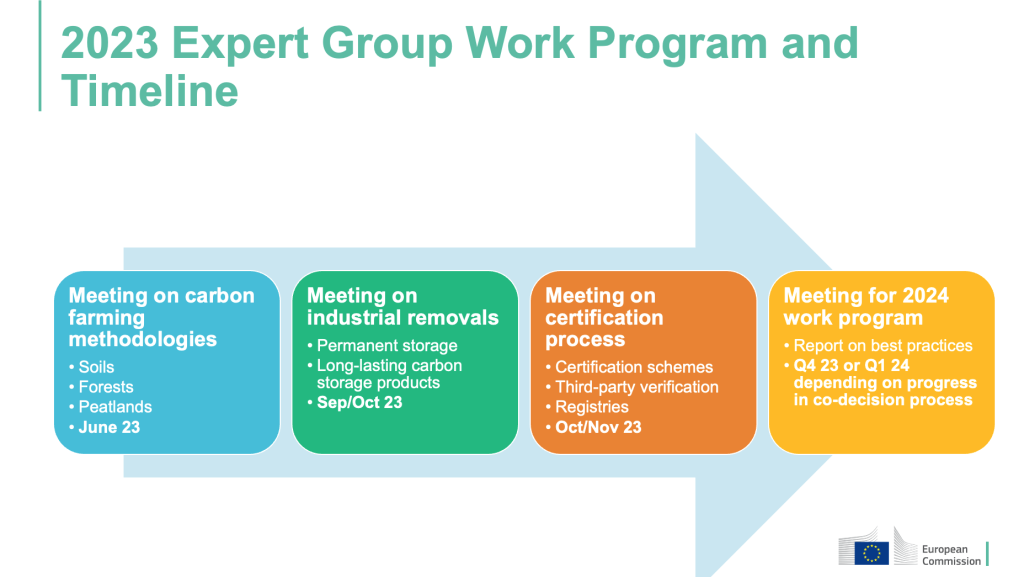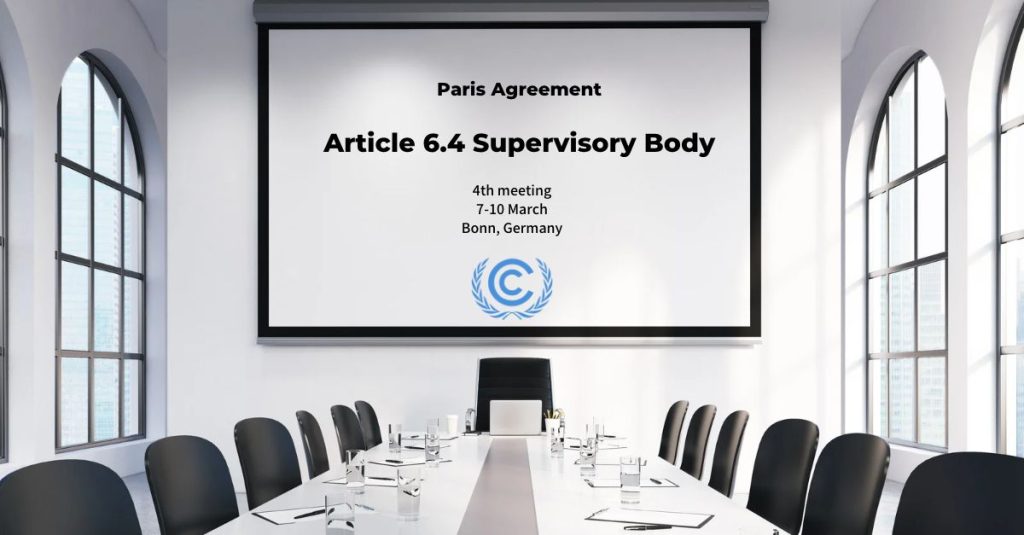
March 2023 laid the groundwork for developing carbon removal methodologies under the EU Carbon Removal Certification and the Paris Agreement. The European Commission’s Carbon Removals Expert Group had its inaugural meeting, and the Article 6.4 Supervisory Body convened for its first session of the year.
Whilst both groups were largely in the planning mode with their carbon removal-related activities, there are a few noteworthy developments to highlight. This post shares key takeaways and reflections, starting with the EU expert group and finishing with Article 6.4 Supervisory Body.
EU Carbon Removals Expert Group gets started
The inaugural meeting of the European Commission’s Carbon Removals Expert Group took place on 7 March, and I attended in my personal capacity in observer status. It was a full house, + numerous attendees online and a very busy agenda. So busy that there was little time for discussion.
The Expert Group started in a closed session by agreeing on the rules of procedure. The group’s decisions are intended to be consensus-based, with simple majority voting as a backup plan. Given the divergent views that already emerged at the first meeting, it is bound to be a challenge. But the group should indeed strive for consensus.
The next step was planning the work for 2023, which will all be about exploration, scoping, and looking at best practices and challenges. There’s a clear distinction between the ongoing co-decision process on Carbon Removal Certification Framework and the expert group’s work on methodologies. One is about the framework, and the other on methodologies. Nothing in the group’s work can prejudge what the framework will look like.

The open session consisted of numerous presentations and Q&A sessions. Surprisingly, in a couple of sessions, the focus seemed to slip from removals to solutions that are not removals but reduce emissions or displace fossil fuel. This hints that some work is ahead to bring the group on the same page regarding the basics.
What merits attention is the composition of the group. There are three types of removal activities under the Carbon Removal Certification Framework (CRCF) proposal — permanent carbon storage, carbon farming, and carbon storage in products. If one looks at the list of members, it becomes clear that the interests of the organisations involved are not equally distributed over the three types of removal activities. Hence, if there is a need to vote (a simple majority vote), this can impact the outcome.
The CRCF proposal is still going through the co-decision process, and the mandate of the expert group is part of that proposal. Several questions were raised during the first meeting regarding the role of the group, and not all of these received clear answers. The CRCF needs to establish a clear (ideally forward-looking) mandate, so everyone knows what’s in and outside the scope of the Expert Group work. Given the group’s composition and upcoming developments (e. g inclusion of removals in the EU ETS), what would be the best use of this group? Should the mandate be kept as narrowly as possible on helping Commission to develop the methodologies for CRCF? Or expanding it wider, given other removals-related considerations? There are bound to be diverging views on this front.
Next steps
A new expert group website will be launched where all the input from stakeholders will be compiled. This content, together with the upcoming meetings on carbon farming, industrial removals and certification processes over 2023 (see below) will feed into a report on best practices. The final timing of the latter depends on the speed of the CRCF co-decision process.

Subgroups of the Expert Group will be formed in 2024, and the real work on methodologies will get started once the Carbon Removal Certification Framework has been agreed upon.
So, what did we achieve?
All in all — we got started. This was the first ever such meeting dedicated exclusively to removals. The main deliverable of the event was agreeing on the rules of procedure and plans for the rest of the year. And for those attending in person, excellent networking opportunities.
Article 6.4 Supervisory Body shapes their work on removals for 2023
Article 6.4 Supervisory Body (SB) met for their first session this year during 7-10 March 2023 in Bonn (recording and documents).
Let’s start with a short recap of what happened before.
The SB spent over 13 hours discussing removals during its previous session before COP27 last year and condensed the recommendations on removals into a 3-page document that was submitted to CMA for adoption. One SB member described this at the March meeting as a “failure has its benefits”, given the attention and input it eventually delivered.
Ultimately, CMA did not adopt these recommendations. Instead, it provided guidance that gave Article 6.4 SB the mandate to “elaborate and further develop” their work on removal over 2023, building on stakeholder input due in March 2023. Read more about the COP27 outcome on removals and why Article 6.4 work on removals matters.

The 7-10 March session took place a week before the deadline for stakeholder input. This is why this meeting focused on other important topics and dedicated less than two hours to discussing removals. Given that the SB mandate required building the work on removals on top of stakeholder input, the group was in waiting and planning mode and didn’t discuss the content.
The most important element of progress in the March meeting regarding removals was establishing a better structure and focus for discussing and possible future stakeholder input by adopting guidance and questions for further work on removals.
It’s crucial to note that the SB work on methodologies is equally important to follow as its guidance on removal activities. That is where the methodologies for emission reduction and removal activities will be developed (see also guidance and questions for further work on methodologies).
Outcome and next steps
The SB will use already received and incoming stakeholder input (the deadline is 15 March) to identify information gaps. These gaps will feed into a structured public consultation with specific questions to receive targeted input. Meanwhile, the informal removals working group within the SB (previous composition listed here) will continue its work and contemplate preparing questions for public consultation to be considered at the next SB meeting in May.
The secretariat will summarise stakeholder input and prepare an updated version of the information note on removal activities. Interestingly, the version of the information note in the March meeting still included elements (e. g tonne-year crediting) that the SB members had repeatedly asked to leave out. Let’s see if the new version will follow the SB guidance more closely.
The SB has four more meetings scheduled on its calendar for 2023. This is not much, given the wide range of areas where SB must deliver by COP28. If a lot of the core work is left for the year’s second half, it will be challenging to deliver on all fronts.
All the decisions on removals taken at the March SB meeting are outlined in point 13 of the meeting report.
Conclusion
Preparations for the work on carbon removal methodologies at the EU and UN levels are progressing simultaneously. Stakeholders have been asking for an exchange of information in both directions to ensure that both systems will rely on robust methodologies informed by the latest developments in this field. 2023 is poised to lay the groundwork in both settings. Let’s ensure it’s a solid foundation for developing carbon removal methodologies.
***
Thank you for reading! Sign up for updates below, and stay tuned for the next posts.
Would you like to use (parts of) the text? Go ahead on the condition that you explicitly refer to this post and include a link.
Thank you!

